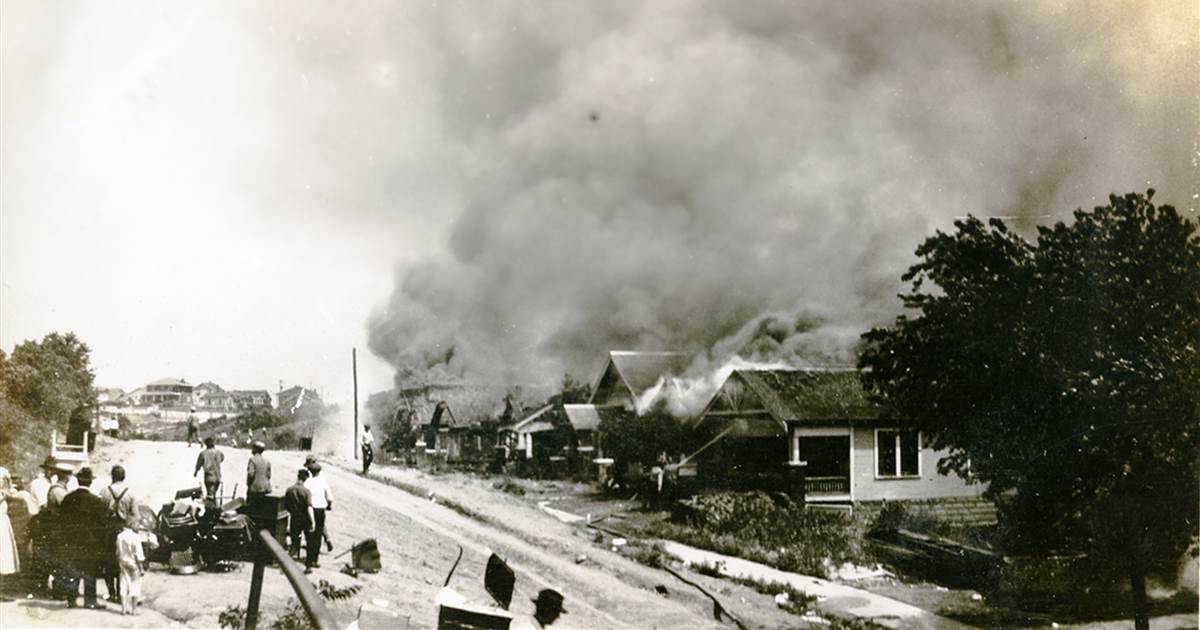The Tulsa Race Massacre took place on May 31 and June 1, 1921, in Tulsa, Oklahoma. In what some historians have called “the single worst incident of racial violence in American history,” residents and businesses of Tulsa’s predominantly Black Greenwood District were attacked on the ground and from the air (private aircraft dropped homemade firebombs) by white mobs who deeply resented the financial prosperity of the residents of what was then known as the “Black Wall Street.” The proximate trigger for the incident was the sensationalist Tulsa Tribune newspaper’s exaggerated and fabricated report of an alleged assault of a young white woman by a young black man; the alleged assault was never substantiated, the alleged victim declined to press charges, and local investigators later speculated that the young man had merely accidentally bumped into the young woman. In less than 18 hours, at least 1,000 homes and businesses were destroyed, hundreds of African Americans were killed, and an estimated 6,000 to 10,000 African Americans were left homeless.
New York Times journalist Charles Blow has offered a commentary on Tulsa that includes these closing words: “It was also about covetousness and spite; about the erasure of a Black excellence that, by its very existence, posed a fundamental threat to White supremacy. Black Wall Street represented Black prosperity, even in an age of oppression, so White supremacy had to destroy it.”
Most news reports that have been recently published or broadcast about the Tulsa Race Massacre focus almost entirely on the violence and brutality of the massacre and the victimization of the Black citizens of Greenwood. Few spend more than scant seconds referencing the context of Greenwood, Oklahoma. Because of that omission, these stories miss a crucially important aspect. The Tulsa Race Massacre is not ONLY another instance of America’s violent victimization of Black people (though it was also that). Rather, the critical context is that Greenwood, Oklahoma in 1921, a community that was almost entirely Black, was one of the most prosperous and successful communities – Black or white – in America. In. America. African American self-sufficiency and self-determination built a thriving, affluent community at a time when much of the country was struggling, a time well before the roaring twenties. And although Greenwood may have been one of the best examples of this, it was hardly the only one. The stereotype that Black = poor is exactly that, a stereotype.
Furthermore, although widely considered the very worst, the Tulsa Race Massacre was neither an isolated incident, nor was it unique in its origins/motivation in “covetousness and spite”. Mass white violence against communities of Black, Indigenous, and People of Color (BIPOC) and Asian-Americans & Pacific Islanders (AAPI) was common throughout the 19th and 20th centuries. Such mass attacks (which exclude the far more numerous individual lynchings and other “smaller scale” acts of white mob domestic terrorism against BIPOC and AAPI people) occurred more than yearly from the end of the Civil War (1865) through the end of World War II (1945), frequently with the involvement or tacit approval of local, state, or federal officials. Included among the most deadly and destructive mass attacks by white mobs against BIPOC and AAPI are:
- California Genocide (1849-70)
- New Orleans massacre of 1866
- St. Bernard Parish Massacre (1868)
- Opelousas Massacre (1868)
- Chinese Massacre of 1871
- Coushatta Massacre (1874)
- Thibodaux Massacre (1887)
- Atlanta Massacre of 1906
- Slocum Massacre (1910)
- East St. Louis Massacre (1917)
- Red Summer (1919)
- Ocoee Massacre (1920)
- Tulsa Race Massacre (1921)
- Perry Massacre (1922)
- Rosewood Massacre (1923)
While mass violent efforts to eradicate and erase thriving affluent, middle-class, and working-class Black communities mostly disappeared in the post-WWII/civil rights eras, other means proved just as devastating. Public officials and planners at local, state, and federal levels frequently employed zoning, highway/bridge construction, and infrastructure siting processes to specifically destroy such communities and the household wealth and livelihoods of their inhabitants. Some far-reaching examples of such purposeful and deliberate efforts are viscerally documented in The Power Broker, Robert Caro’s Pulitzer Prize-winning biography of the powerful and feared mid-20th century New York City and state public works official Robert Moses.
Below is the only surviving footage of the hugely successful, prosperous Greenwood community of Tulsa and of the massacre that destroyed it.
Below is a dramatization of the Tulsa Race Massacre as filmed for HBO’s series Watchmen.
Below is video of 107 year old Tulsa Race Massacre survivor testifying before Congress on May 26, 2021.


